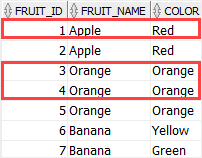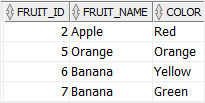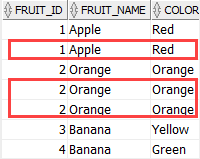Summary: in this tutorial, you will learn step by step how to delete duplicate records in Oracle Database using the DELETE statement with a subquery.
Once you’ve found the duplicate records in a table, you often want to delete the unwanted copies to keep your data clean.
If a table has a few duplicate rows, you could do this manually one by one by using a simple
DELETE statement. However, it is time-consuming to do it manually if the table has a large number of duplicate records. It is better to construct a single statement that removes all unwanted copies in one go.
Before removing the duplicate records, you must decide which instances you want to keep. For example, you may want to preserve the newest or oldest row. In this case, you need a column in the table like
id column that is not the part of the group used to evaluate duplicate.
Consider the following
fruits table:
Suppose you want to keep the row with the highest
fruit_id and delete all other copies. The following query returns the last entry for each combination of fruit_name and color:
You use the following
DELETE statement with a subquery to delete rows whose values in the fruit_id column are not the highest ones.
Three rows were deleted which is what we expected:

Likewise, if you want to keep the row with the lowest id, you use the
MIN() function instead of the MAX() function:
This method above works if you have a column that is not part of the group for evaluating duplicate. If all values in all columns can have copies, then you cannot use the
fruit_id column anymore.
In the
fruits table, the values in all columns fruit_id, fruit_name, and color have copies.
In this case, you can use the
rowid which is a physical locator that specifies where on storage Oracle stores the row. Because the rowid is unique to each row, you can use it to remove the duplicates as shown below:
The following query verifies the delete operation:

Second Approach:
5 ways to delete duplicate records Oracle
In Oracle there are many ways to delete duplicate records. Note that below example are described to just explain the different possibilities.
Consider the EMP table with below rows
create table emp(
EMPNNO integer,
EMPNAME varchar2(20),
SALARY number);
EMPNNO integer,
EMPNAME varchar2(20),
SALARY number);
10 Bill 2000
11 Bill 2000
12 Mark 3000
12 Mark 3000
12 Mark 3000
13 Tom 4000
14 Tom 5000
15 Susan 5000
11 Bill 2000
12 Mark 3000
12 Mark 3000
12 Mark 3000
13 Tom 4000
14 Tom 5000
15 Susan 5000
1. Using rowid
SQL > delete from emp
where rowid not in
(select max(rowid) from emp group by empno);
where rowid not in
(select max(rowid) from emp group by empno);
This technique can be applied to almost scenarios. Group by operation should be on the columns which identify the duplicates.
2. Using self-join
SQL > delete from emp e1
where rowid not in
(select max(rowid) from emp e2
where e1.empno = e2.empno );
where rowid not in
(select max(rowid) from emp e2
where e1.empno = e2.empno );
3. Using row_number()
SQL > delete from emp where rowid in
(
select rid from
(
select rowid rid,
row_number() over(partition by empno order by empno) rn
from emp
)
where rn > 1
);
(
select rid from
(
select rowid rid,
row_number() over(partition by empno order by empno) rn
from emp
)
where rn > 1
);
This is another efficient way to delete duplicates
4. Using dense_rank()
SQL > delete from emp where rowid in
(
select rid from
(
select rowid rid,
dense_rank() over(partition by empno order by rowid) rn
from emp
)
where rn > 1
);
(
select rid from
(
select rowid rid,
dense_rank() over(partition by empno order by rowid) rn
from emp
)
where rn > 1
);
Here you can use both rank() and dens_rank() since both will give unique records when order by rowid.
5. Using group by
Consider the EMP table with below rows
10 Bill 2000
11 Bill 2000
12 Mark 3000
13 Mark 3000
11 Bill 2000
12 Mark 3000
13 Mark 3000
SQL > delete from emp where
(empno,empname,salary) in
(
select max(empno),empname,salary from emp
group by empname,salary
);
(empno,empname,salary) in
(
select max(empno),empname,salary from emp
group by empname,salary
);
This technique is only applicable in few scenarios.
Always take extra caution while deleting records.
1. First identify the duplicates using select.
2. Double verify those are actual ‘duplicates’ or not
3. Take backup if necessary
4. Apply commit only if you are sure.
Did you find above post useful ? Your comments are highly valuable.
No comments:
Post a Comment